Essential Tools for Effective Drywall Patching
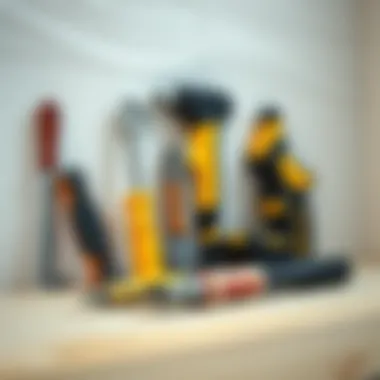
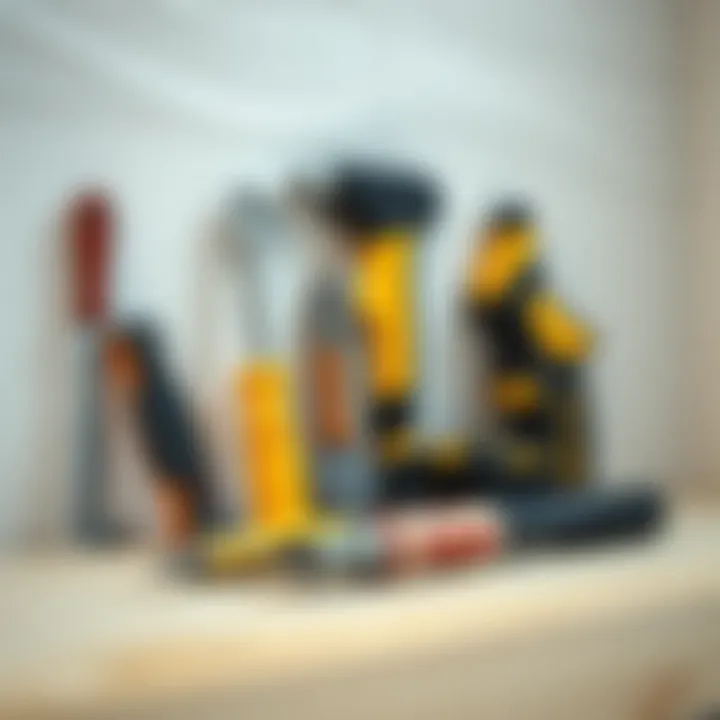
Intro
Patching drywall can seem like a daunting task, but it need not be rocket science. With a handful of essential tools and materials, anyone can tackle this home maintenance task head-on. Whether you've got a small dent from a wayward door or a larger hole due to some unfortunate miscalculations during your last home project, knowing the right equipment and materials to use can make all the difference.
This guide is designed for homeowners, DIY enthusiasts, and anyone looking to enhance their skills in home repair. By arming yourself with the correct tools and knowing the best patching materials for the job, you'll be well on your way to achieving a smooth, professional-looking finish that can withstand the test of time.
Let’s check out the key tools and supplies you’ll need to patch drywall effectively, along with some techniques that will ensure that your repairs are virtually invisible when you're done.
Preface to Drywall Repair
Patching drywall is not merely a task reserved for seasoned contractors or construction experts; it's an essential skill that even the most novice homeowners can master. This article unfolds the critical elements of drywall repair, encompassing tools, materials, and methods to achieve a professional finish. Through understanding drywall and its common pitfalls, one can not only restore the integrity of their home but also enhance its aesthetic appeal.
Repairing drywall goes beyond fixing unsightly cracks and holes. It effectively serves to maintain the structural integrity of your living space, prevents moisture intrusion, and even bolsters energy efficiency. A compromised wall can lead to bigger problems down the line, such as mold growth or more severe structural issues, making timely patching crucial. Knowing how to do this yourself saves money and fosters a sense of accomplishment with each successful repair.
Moreover, familiarity with drywall repair can transform your approach to home improvement. Knowledge of best practices and proper techniques helps in executing projects swiftly and efficiently, reducing stress and errors during repair. Fixing up instead of tearing out may also support a environmentally-friendly lifestyle, making this skill particularly appealing in today's eco-conscious climate.
Take note: the journey to proficient drywall repair doesn’t end with one successful patch. As we dive deeper into this guide, you will discover various aspects of drywall—what it is, the common causes of damage, the tools and materials you need, and effective techniques for repair. All these elements work together, equipping you with the confidence to approach drywall repair like a pro.
Understanding Drywall and Its Uses
Drywall, also known as gypsum board or wallboard, has become a staple in modern construction. Consisting of a gypsum core sandwiched between two sheets of sturdy paper or fiberglass, it is popular due to its easy installation and versatility. Most homes today rely heavily on drywall for interior walls and ceilings, providing not only a smooth finish for paint or wallpaper but also acting as a barrier against sound.
In terms of applications, drywall is not limited to just residential settings; it is used in schools, offices, and commercial spaces as well. Its ability to be cut, shaped, and fitted to just about any space makes it a go-to material for architects and builders. Understandably, homeowners should be aware of its various uses and properties, as these factors influence how it should be cared for over time.
"Understanding the material you're working with is the first step to mastering the art of drywall repair."
Common Causes of Drywall Damage
While drywall is admired for its practicality, it's not entirely impervious to the wear and tear of everyday life. Various factors can lead to damage, such as accidental impacts—one innocent swing of a door or bump from furniture can leave a noticeable dent. Even the slightest changes in temperature can affect its texture and integrity.
Moisture is another significant enemy to drywall. Leaks from pipes or roofs, or even excessive humidity, can compromise its structural soundness, leading to mold growth or sagging. As a homeowner, staying alert to such potential issues can save you from costly repairs down the line. Other common culprits include:
- Nail pops: Caused when nails or screws used for fastening drywall to studs shift over time, protruding from the surface.
- Pest activity: Insect infestations can lead to gnawing or drying out areas of the drywall.
- Accidental cuts: During cleaning or furniture rearranging, it’s easy to scrape or cut the surface if one isn't careful.
By understanding these causes, you can not only take proactive measures to protect your walls but also prepare yourself for repairs when accidents do happen.
Assessment of Damage
Assessing damage is a crucial first step in the process of patching drywall. By properly identifying the extent of damage, you can determine not just the materials needed, but also the methods for effectively repairing your walls. Rushing into repairs without a thorough evaluation could lead to either unnecessary work or, worse, temporary fixes that don’t hold up over time. Taking the time to assess the damage allows homeowners to develop a plan that will ultimately save time and resources, ensuring that repairs are long-lasting and effective.
Identifying Types of Damage
When it comes to drywall, damage can manifest in various forms, each requiring a unique approach. The most common types include:
- Holes and Dents: Often caused by accidental impacts from furniture or equipment. Small holes can be simply patched, while larger ones may need additional framing support.
- Cracks: These can appear due to the settling of the house or temperature fluctuations. Some cracks might be superficial, while others might indicate more significant structural issues.
- Water Damage: Usually causes discoloration and softness in the drywall. It’s essential to assess the source of the moisture to prevent future problems.
- Mold Growth: Appears in areas with persistent humidity and can often require removal of the affected drywall portion. Not only is it unsightly, but it can also pose health risks.
Identifying these types requires a keen eye. Make sure you inspect not just the visible areas, but also behind outlets, in corners, and around windows.
Evaluating Required Repairs
Once you have identified the types of damage, the next step is to evaluate the necessary repairs. This evaluation should take into account:
- Severity of Damage: Can small holes be patched easily, or do larger damages require significant work? Understanding the scope helps in planning your repair strategy.
- Existing Underlying Issues: If there’s water damage or signs of mold, addressing the underlying problem is key before patching. For instance, fixing a leaky pipe will prevent future deterioration of the drywall.
- Time and Resources: Evaluate how much time you want to invest and whether you have the tools and materials at hand. Sometimes, complex repairs may require professional help; understanding this early on can save you frustration.
- Desired Finish: Consider if you want minimal aesthetic repair or a flawless finish. This would dictate whether you opt for quick fixes or more meticulous methods.
Assessing damage with care is like looking at an iceberg: much of it sits hidden beneath the surface, and proper evaluation can mean the difference between a quick patch and a lasting repair. Poor assessment often results in repeat costs and disruptions.
"A stitch in time saves nine." - Ensuring proper assessments prevents future headaches and expenses.
Tools Needed for Patching Drywall
Patching drywall is not just a task; it's an art. Having the right tools at your fingertips makes all the difference. When it comes to fixing those pesky holes or scratches, the quality of your repair hinges on the tools you select. From hand tools that require precision to power tools that speed up the process, knowing what you need is crucial. Each tool has its own unique benefits and using the right one at the right time can really save you a headache—or a few extra hours on your project.
Essential Hand Tools
Utility Knife
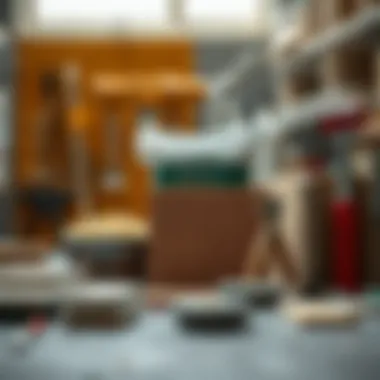
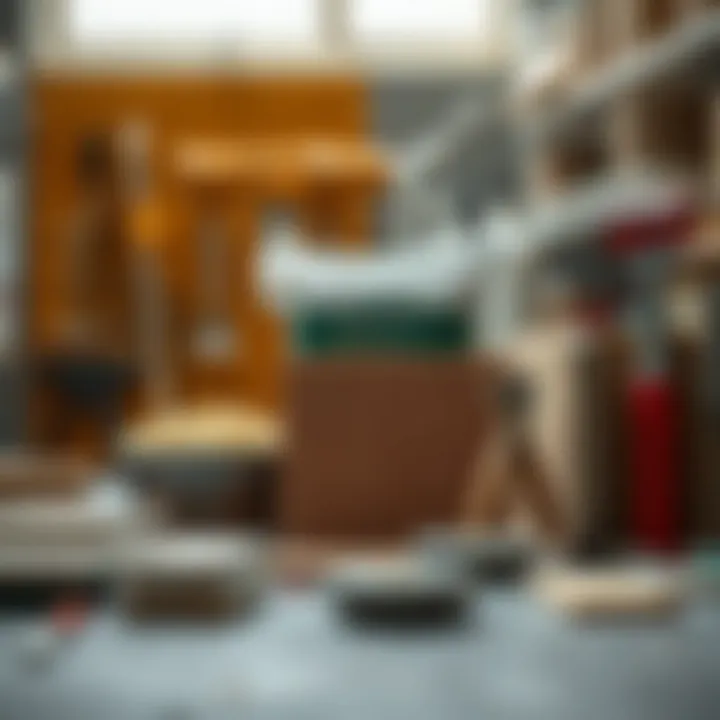
The utility knife, short and simple, is often a hero in the world of drywall repair. Its sharp, retractable blade allows for clean cuts, crucial when you’re trimming drywall patches or scraping off excess joint compound. One of the main features setting it apart is its ease of use; it’s as simple as pressing a button to extend or retract the blade. This tool is popular among DIYers for its versatility and effectiveness. The downside? A dull blade can make your job messy, leading to jagged edges on your cuts. So, always keep a few spare blades handy to keep the work efficient and neat.
Drywall Saw
When your drywall repair project kicks it up a notch, you’ll want to reach for a drywall saw. This tool is designed specifically for cutting drywall with precision. Its key characteristic is a tapered blade that allows for easy maneuvering in tight spaces, making it perfect for those holes made by careless doorknobs or errant toys. It’s a favorite because it gets the job done swiftly without needing a power source. However, using a drywall saw requires a steady hand; otherwise, you may end up with uneven cuts that can complicate your repair efforts.
Tape Measure
Get ready to put your measuring skills to the test, because the tape measure is an unsung hero here. Accurate measurements are essential when patching drywall; your patch needs to fit snugly in its place. The most striking feature of a tape measure is its retractable design that allows for easy storage. Many folks find it handy that a good tape measure typically has both metric and imperial markings. The downside? Failing to keep it straight while measuring can lead to miscalculations, resulting in patches that are either too big or pitifully small for the task.
Power Tools for Efficiency
Drill and Bits
A good drill makes light work of any task, and when it comes to drywall, it’s no exception. Drills paired with the right bits allow you to fasten drywall sheets securely, ensuring your repairs last longer and can withstand some wear and tear. The remarkable aspect of a drill is its versatility—it can also be used for other home projects, proving its worth over time. However, improper use can lead to over-drilling, which may cause additional damage that defeats the purpose of your repair.
Sanding Tools
After the patching is done, sanding becomes your best friend. Sanding tools smooth out the surface, making the repaired area blend perfectly into the existing wall. Most sanding tools come with a range of grits, so you can tackle different finishes as needed. Their key feature is efficacy; with just a few passes, you can achieve a polished look. The catch? If you apply too much pressure while sanding, you risk creating dips or uneven textures, which can be frustrating.
Vacuum Sander
Now here’s a tool that stands out like a sore thumb—quite literally! Vacuum sanders not only help in finishing your drywall repairs, but they also minimize the dust mess that comes along with traditional sanding methods. The unique trait of a vacuum sander is its ability to suck up the dust as you go, fostering a cleaner work environment. While it may take a bit of getting used to for those not familiar with it, the advantages clearly outweigh the minor learning curve.
Remember, the right tools can make a world of difference in your drywall repair efforts. Don’t underestimate the power of preparation and having the right gear!
In summary, the tools you've got in your arsenal can either elevate your drywall repair experience or turn it into a right headache. Equip yourself well and you'll be well on your way to expertly handling any drywall flaws that come your way.
Materials for Patching Drywall
When it comes to patching drywall, having the right materials is as crucial as mastering the techniques. Opting for suitable patching materials can literally make or break your work quality—those little details can lead to a smooth surface or a noticeable blemish. Choosing the right materials not only impacts the finished look but also determines the longevity of your repair work.
Selecting materials should be based on the specific issues you're facing. For instance, the kind of damage or area you're fixing plays a big role. The best materials provide a strong, durable repair, ensuring that the patched areas blend seamlessly with the surrounding wall.
Keep in mind that some patching compounds are easier to work with than others, which can be significant for someone with limited experience. Ultimately, understanding the distinctions between your options contributes not just to aesthetics but to the overall integrity of your home’s interior. Here, we present several materials that stand out in the drywall patching realm.
Types of Drywall Patch Compounds
Different compounds exist for varying repair needs. Let’s delve into each one:
Joint Compound
Joint compound, a staple in drywall finishing, is widely favored for its versatility. It's mainly used for taping seams and covering imperfections. One of the key characteristics of joint compound is its ease of application; it goes on smoothly and can be feathered out to create hardly noticeable edges.
The beauty of joint compound lies in its ability to be sanded down easily once dry, allowing for a smooth finish that is ideal for painting. However, it takes longer to dry than other products, which can potentially slow down your repair project. In contrast, its user-friendly nature and affordability make joint compound a solid choice for both novices and experienced DIYers alike.
Spackle
Spackle is often seen as the speedy option when it comes to minor holes or scratches. The key characteristic here is its quick-drying formula—spackle usually sets fast enough for many people to apply paint within just a couple of hours after completion. This makes it quite popular for quick touch-ups.
However, it's important to note that spackle is generally more suitable for smaller repairs. It’s not the best option for larger damaged areas, as it doesn't provide the same level of strength and adherence as joint compounds. For small nicks and dents, though, spackle shines brightly as both a convenient and effective material.
Mesh Tape
While not a compound per se, mesh tape is a vital accessory when patching drywall. This self-adhesive tape provides additional support at seams and is resistant to cracking. The key characteristic of mesh tape is its ability to adhere without requiring additional glue, making the process quicker and easier.
The unique feature of mesh tape is its breathable design, which allows joint compound to flow through and create a firm bond. One downside is that it can be slightly tricky for beginners, especially regarding the application technique. Nevertheless, once mastered, using mesh tape can significantly enhance the quality of your repairs.
Selecting the Right Patch for the Job
Choosing the correct patch depends on both the extent of the damage and your timeline for repairs. Some options offer benefits that are more suited for particular situations.
Pre-Mixed vs. Powdered
Pre-mixed patching compounds come ready to use out of the bucket. This convenience means fewer tools needed for mixing, which can be appealing for those who are short on time. The key attribute here is consistency; you can expect a uniform texture, which often results in a smoother finish. However, if you're after a specific consistency or texture, powdered compounds can offer more flexibility as you control the mixing.
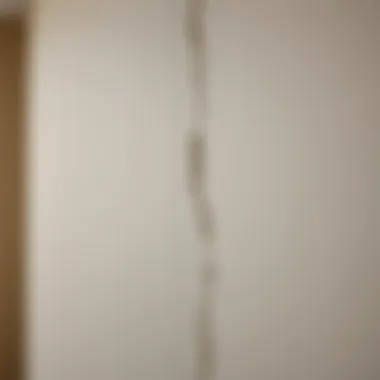
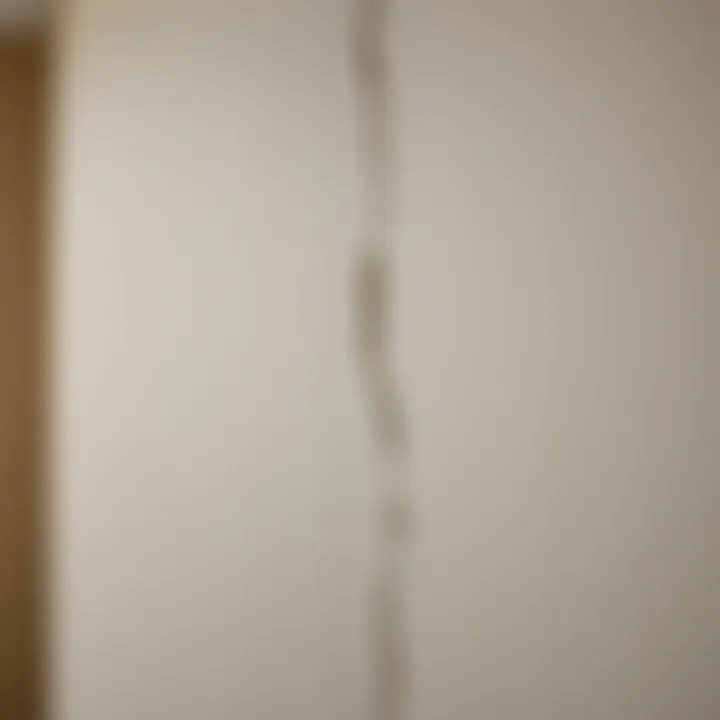
Powdered patches also have a longer shelf life, making them ideal for someone who doesn’t do patching often. The downside could be the time involved in mixing it correctly. Nevertheless, both pre-mixed and powdered have their deserved places depending on your skill and the complexity of the job.
Quick Setting Options
Quick setting compounds are becoming increasingly popular among DIY enthusiasts. The high-speed drying nature of these products means you can move from one stage to the next without unnecessary waiting. They have unique features that allow them to cure in as little as 20 minutes. This quality is particularly advantageous for those with tight schedules.
While fast-drying products do speed things up, they can sometimes make it challenging for less experienced users to work quickly enough to achieve a smooth finish. Considering the pros and cons, quick setting options are best suited for larger repairs or demanding timelines, though they might not be ideal for detailed finishing work.
With the landscape of patching materials in mind, it becomes clear that choosing the right one can contribute significantly to the outcome of your drywall repair efforts. Being informed about the materials will allow you to hone in on what suits your specific project, making the task considerably more manageable.
Preparation for Patching
Preparing for patching drywall is a crucial step that can largely determine the success of your repair. Without adequate preparation, you may end up with a finish that’s less than satisfying. Ensuring your workspace is organized and ready to go will help in minimizing errors and saving time. It’s about laying down the groundwork, so when you dive into the actual patching process, everything goes off more smoothly. Think of it like the foundation of a house — no solid base, and everything else may just tumble.
Cleaning the Work Area
Before starting any patchwork, the first order of business should be cleaning the work area thoroughly. Dust, debris, and old materials can interfere with adhesion and the overall finish. For instance, if you’ve had a leak and the drywall has been readily exposed, mold can be an issue. Not only will poor cleanliness complicate the application of your next steps, but it may also lead to aesthetic pitfalls down the line. Here are some practical steps for cleaning up your area:
- Move furniture or any items that could obstruct your work. You don’t want to trip over a table leg or find paint splatters on a beloved couch afterward.
- Use a damp cloth to wipe down surfaces where dust has settled. This can also prevent dirt from mixing into your patch compound.
- If there are any loose materials around the repair area, remove those as well.
Proper cleaning will set the stage for your patching process and contribute to the durability of the repair.
Gathering Tools and Materials
Once your area is spotless, it's time to gather all the necessary tools and materials. Having everything at hand will keep your workflow optimal and minimize the temptation to make unnecessary trips to the hardware store. It's easy to lose focus when you realize you've forgotten a crucial item. Here’s a checklist of what you might need for patching:
- Utility Knife: Crucial for cutting out damaged drywall or trimming your patch material.
- Drywall Saw: If you’re patching larger holes, a drywall saw can come in very handy.
- Tape Measure: Never underestimate the power of a good tape measure. Getting the dimensions right before you cut can save you a lot of hassle.
- Joint Compound: Choose between pre-mixed or powdered versions depending on your comfort level and job requirements.
- Spackle: Ideal for minor repairs or smaller cracks.
- Sanding Block or Sponge: This will be essential for smoothing your patch after it has dried.
- Putty Knife: A trusty putty knife is needed for applying joint compounds evenly.
Organizing all your tools in special range will cut down on any frustration once you get started. However, only gather what you need to keep your area spacious and clutter-free.
"Preparation is the key to success, as they say. The more prepared you are, the less you will have to scramble when the time to patch comes!"
By aapproaching the prep work methodically, you set yourself up for not just a quick fix, but a professionally-looking finish. Taking those few moments to ensure your space and tools are ready can make the difference between a project well done and one that leaves you regretting shortcuts. Remember, a little extra effort in preparation goes a long way in DIY endeavors.
Techniques for Patching Drywall
Understanding the right techniques for patching drywall is key to achieving a lasting and professional finish. Mastering these techniques not only improves the aesthetics of your walls but also extends the lifespan of your repairs. Attention to detail is vital; minor errors can lead to major discrepancies in the finished look.
Applying Joint Compound
Applying joint compound is a foundational step in drywall repair. This substance acts as the filler, bridging gaps and smoothing out uneven surfaces. To start, make sure you mix the compound to a creamy consistency; if it's too thick, it can be difficult to spread. Using a taping knife, apply a generous amount to cover the patch area completely. It’s important to work the compound into the edges of the patch to avoid a noticeable ridge. Aim for thin layers; it is more effective to apply several coats rather than one thick one. Here’s a tip: sweeping the knife from the center outwards allows for a more fluid application and reduces the potential for air bubbles.
"Applying joint compound is an art. With patience and precision, anyone can achieve a seamless repair."
Sanding and Smoothing the Patch
Once the joint compound has dried, the next step is sanding and smoothing the patch. This process is crucial for creating a surface that blends seamlessly with the rest of the wall. Start with a medium-grit sandpaper to knock down any high spots, then follow up with a fine-grit to refine the edges, making them as smooth as butter. Avoid aggressive sanding, as it can lead to uneven patches or damage the drywall underneath. It's helpful to use a sanding block or electric sander for larger areas; this ensures an even pressure across the surface. A tip for avoiding dust clouds: keep a vacuum nearby to catch the debris as you sand, maintaining a cleaner workspace.
In this stage, the goal is to create a surface that not only looks professional but feels right to the touch. As you progress, it’s often beneficial to run your hand over the patched area; if it feels smooth, you’re on the right track. After achieving the desired smoothness, don’t forget to clean the area thoroughly before proceeding to priming and painting.
For anyone focused on DIY home repair, these steps emphasize the importance of quality work. The techniques discussed ensure that your drywall repairs not only fulfill their purpose but also elevate the overall look of your interior spaces.
Finishing Touches
After the heavy lifting of patching drywall, the finishing touches are crucial to achieving a flawless final look. This section emphasizes the importance of priming and painting the repaired areas, ensuring that your hard work pays off in the end. The objective here is to create a seamless blend between the old and new surfaces, giving your wall a polished appearance.
Priming the Repaired Area
Priming is a step that should never be skipped. When you apply joint compound or any patching material to drywall, you create a different texture and absorbency compared to the surrounding surface. If you simply jump to paint after patching, chances are good that the patched area will absorb paint differently, leading to noticeable color variations.
Using a good quality primer can resolve this problem. It evens out the porosity of the patched area and helps the paint adhere more effectively. Choose a primer that’s specifically formulated for drywall repairs, as these often contain additives to enhance adhesion and coverage. Applying primer not only prepares the surface for paint but also assists in blocking stains, ensuring the final finish remains true to its intended color.
"Skimping on primer could lead to blemishes that usually cost more to fix than just doing it right the first time."
Painting for a Seamless Blend
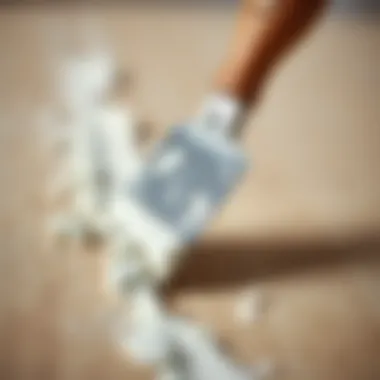
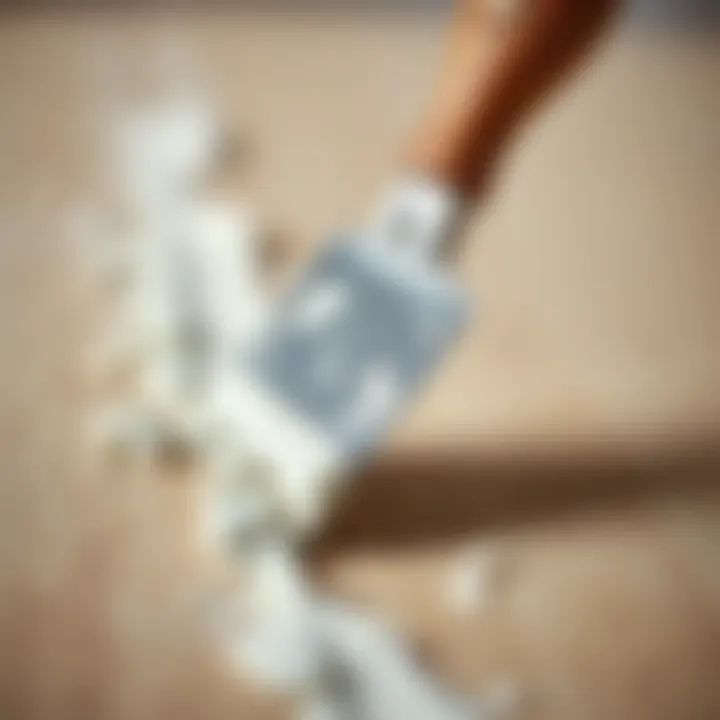
After allowing the primer to dry completely, it’s time to reach for the paintbrush. Choosing the right paint is essential for a seamless blend. Ideally, you want to match the existing wall color. This may require visiting your local hardware store where professionals can help you color match with various tools.
When painting the patched area, begin by applying paint along the edges where the new and old surfaces meet. This method, often referred to as 'cutting in', creates a smoother transition and helps avoid any harsh lines that can draw the eye. Once the edges are done, use a roller to cover the remaining surface with long, even strokes.
Lastly, don’t rush through multiple coats. It’s wise to allow adequate drying time between coats, as this adds depth and improves durability. The more effort you put in at this stage, the happier you’ll be with the end result, making your entire repair a visually pleasing success.
By taking the time to carefully prime and paint your patched drywall, you not only enhance the aesthetic appeal of your space but also safeguard your work against future wear and tear. Remember, good finishing touches can make all the difference.
Common Mistakes to Avoid
When it comes to patching drywall, even the most experienced DIY enthusiasts can stumble on various pitfalls. Understanding and avoiding these common mistakes can save time, effort, and frustration. This section presents two significant mistakes that often complicate repairs and may lead to unsatisfactory results. By knowing what can go wrong, homeowners can mitigate risks and work towards achieving a smooth and flawless finish.
Over-Application of Compound
One of the primary blunders in drywall repair is the tendency to over-apply joint compound. While it's tempting to load up the compound to cover imperfections, this can lead to a lumpy and uneven surface. When too much compound is poured on, it can cause excessive sanding later, increasing effort and time for the entire process.
Using the right technique is vital. A light application is recommended, building layers gradually instead of going all in at once. This approach can avoid a heavy, clumpy result. Here are some steps to avoid over-application:
- Start with a thin layer of joint compound to fill in the damaged area.
- Use a wide drywall knife to spread the compound evenly.
- Allow the first layer to dry completely before applying additional coats.
Tip: It's essential to remember that multiple thin coats yield a better result than one thick layer. Managing the thickness will also allow for easier sanding and a neater finish.
Neglecting Surface Preparation
Surface preparation lays the groundwork for a successful patch job. Skipping this step can be a recipe for disaster, leading to adhesion issues and a patch that may soon peel away. Properly prepping the area ensures that the joint compound adheres well and creates a lasting bond.
Prior preparation involves cleaning the damaged area thoroughly to remove dust, grease, or old paint. It's also crucial to assess the surrounding surfaces for any damage that might affect the new patch. Here’s a brief clarification on effective surface prep:
- Clean the Area: Use a damp cloth or sponge to remove debris.
- Sand Edges: Feathering the edges around the patch site helps create a smoother transition.
- Check for Moisture: Ensure that the area is dry before applying the compound."
Remember, a few extra minutes spent prepping will save you hours later on.
When to Call a Professional
Repairing drywall may seem like a straightforward task, however, there are times when the best course of action is to pick up the phone and call in a professional. This section covers the nuances of when to engage an expert, shedding light on specific elements and considerations that underscore the importance of professional intervention.
Assessing Complex Damage
Sometimes damage to drywall goes beyond the usual nicks or small holes; it might indicate a more significant problem lurking beneath the surface. When you spot large cracks or bulges, it's worth taking a step back.
- Large Holes: Should the damage extend beyond a simple patch, like holes greater than six inches, it’s a sign that you might need someone with experience.
- Water Damage: If your drywall has been soaking wet due to leaks or flooding, it's not only about patching over it. Mold and structural integrity can be at risk here, and a trained professional can diagnose and remedy these issues effectively.
- Cracks Across Multiple Walls: Cracks that appear in various places can signal shifts in the structure of the house itself rather than just the drywall. An expert can assess whether it’s settling or a more serious foundation issue.
In these cases, a professional can provide a thorough evaluation that includes not just cosmetic repairs but also addressing root problems. The last thing anyone wants is for a quick patch job to turn into a recurring headache.
Understanding Structural Issues
Structural concerns can be daunting. When the walls begin to show signs of sagging or there's a persistent draft that wasn’t there before, the situation warrants closer scrutiny.
- Sagging Walls or Ceilings: These can indicate that critical support beams have weakened. This type of damage isn't just superficial; it can jeopardize the safety of the entire structure.
- Permeating Water Leaks: If drywall is soft or rotting due to undiscovered leaks, it’s indicative of a far-reaching issue. Water ingress will lead to costly damages if not handled promptly and correctly.
- Alignment Problems: If you notice doors or windows that stick when opened or closed, this could suggest that the framing for those openings has shifted, pointing to issues that require more than just patching.
In the realm of home repairs, knowing your limits is key. A professional brings a wealth of knowledge and the right tools to ensure that repairs are not just a temporary solution, but a reliable fix.
“Engaging a professional can prevent small issues from escalating into much larger, costlier headaches.”
End
When you invest your time in acquiring and using quality tools, you set yourself up for success. Good tools make the work feel less daunting and result in cleaner, more professional-looking repairs. Understanding what materials to use is equally vital; knowing whether to choose joint compound or spackle can make a significant difference based on the severity of the damage and the final look you are aiming for.
Moreover, mastering the art of drywall repair is not only beneficial for your living spaces but also enhances your overall skill set in home maintenance. It builds confidence and allows for personal expression in your home’s aesthetic.
Summary of Key Points
- Essential Tools: Acquiring quality hand tools like utility knives, drywall saws, and power tools such as drills and sanders is fundamental. Each has a specific role that contributes to a smooth repair process.
- Materials Matter: The choice between joint compound, spackle, and other patch materials greatly influences the quality of your repairs. Understanding their properties can lead to better decisions.
- Preparation: An organized workspace and the right preparations can drastically affect the outcome. Don’t rush into the patching process without ensuring you have everything at hand.
Encouragement for DIY Enthusiasts
For those who take pride in fixing up their home, don’t shy away from tackling drywall repairs on your own. Sure, it can feel overwhelming at times, but remember that it’s all a learning experience. Each patch you work on adds to your skill set and gives you a better understanding of home maintenance as a whole.
Start small, mastering basic techniques before tackling more complex areas. You’d be surprised at how quickly your confidence builds up once you see the results of your work. Plus, taking these repairs into your own hands not just saves money; it also allows you to customize your space exactly how you want it. The satisfaction of standing back and appreciating a job well done is worth every bit of elbow grease.
So, gather those tools, arm yourself with the right materials, and get to patching! You’ve got this!







